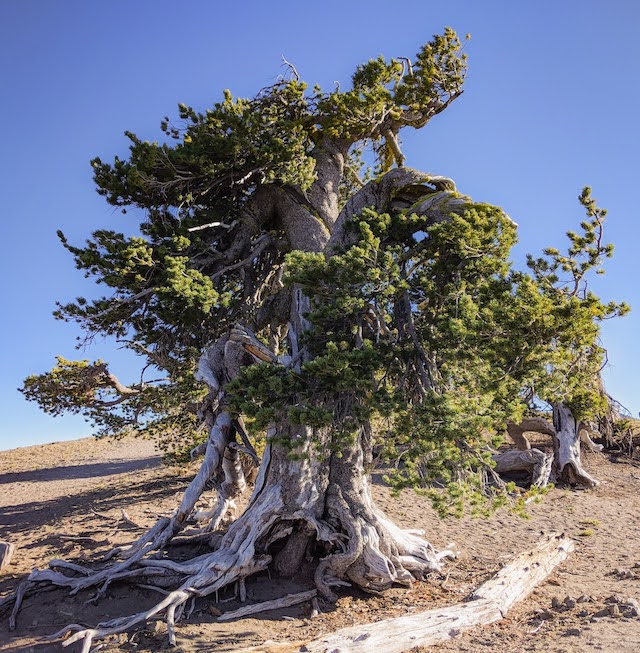By Benjamin Alva Polley EBS COLUMNIST
Whitebark pines, the five-needled trees that thrive in the harsh, rocky environments of high-altitude western North America, are precarious. Classified as threatened under the Endangered Species Act, they face continuing threats from white pine blister rust and mountain pine beetle infestations, which are exacerbated by climate change.
However, people are finding solutions to save them, recognizing their importance as a keystone species.
White pine blister rust, a non-native fungal disease, was once present only in localized areas of North America. The significance of the disease was realized in 1906 when the Ribes plantation in New York, Agricultural Experiment Station, became infected. It has spores spread through the wind and affects the five-needle white pine species, including limber, sugar, Western white pine, bristlecone pines and whitebark. Infected trees develop blisters, a sporulating stage of the ruse that first occurs about two to three years after infections, often killing them within 10 years.

Mountain pine beetles, while native and part of the ecosystem, kill only mature trees. They have caused extensive damage to forests, leading to significant mortality among mature trees and cone-bearing trees. The outbreak is considered one of North America’s most extensive insect infestations since European colonization, and it has devastated approximately 125 million acres in western states and southern Canada.
“Blister rust is an insidious disease that spreads… with the right climactic conditions—which have occurred frequently enough in Yellowstone to foster the spread of this disease,” said Diana Tomback, a professor of integrative biology at the University of Colorado Denver. She also serves on the board of the Whitebark Pine Ecosystem Foundation and the US Fish and Wildlife Service Whitebark Pine Recovery team.
“We’re seeing 25% or higher infection rates from white pine blister rust in the Greater Yellowstone area,” Tomback said. Now that the mountain pine beetle outbreak has ended, the majority of mortality is caused by blister rust.
However, mountain pine beetles are native to the West. They attack all pines, including five-needle white pines, especially lodgepole and ponderosa pines.
“Up to 80 to 90% of mature cone-bearing trees in some watersheds were killed by mountain pine beetles during peak outbreak,” Tomback said, referring to the early to mid-2000s. “Fortunately, there are now low levels of new mortality.”
Tomback and others are concerned that beetles might surge again, but there are tools to protect some trees. Verbenone pouches can be placed on some trees to inform mountain pine beetles that the tree is already infested and tell them to leave it alone. These natural pheromones can be chemically and artificially produced but aren’t practical for many trees.
Importance of whitebark pine
Whitebark pines are critical in their ecosystem, serving as a foundational keystone species.
“This keystone species is central to many interactions with plants and animals and promotes biodiversity,” Tomback said. “Due to its large, nutritious seeds, it attracts various small birds and mammals, from Clark’s nutcrackers, which are the primary seed dispersers, to grizzly and black bears.”

Bears rely on whitebark pine seeds for food before hibernation. In years of abundant whitebark pinecone production, grizzlies produce more cubs and avoid human-populated low-elevation areas, such as campgrounds, picnic areas and towns.
Michael Giesey, a former USFS silviculturist and current board member and chair of the Ski Area Partnership Committee of the Whitebark Pine Ecosystem Foundation, notes that a single whitebark pine seed is very nutritious, primarily because of its large size.
“They are a treasure trove of nutrients for any creature out there.”
Various mammals, rodents and birds, including crossbills, nuthatches, chickadees, pine grosbeaks, blue grouse, Steller’s jays, and some woodpeckers, all consume whitebark pine seeds.
Whitebark pines also provide ecosystem services by offering habitat for various animals at the highest elevations, including nesting songbirds, raptors, elk and deer. They help prevent soil erosion, redirect snow—functioning like snow fences—to help capture and build snowpack, contribute to snow stability by preventing avalanches and enhancing downstream water flow, which is crucial in climate change.
Once these trees are gone, essential ecosystem functions will be lost.
Solutions
Established in 2001, the WPEF is crucial in advocating the preservation of whitebark pines. Its primary objective is facilitating collaboration between researchers and federal managers, ensuring that the most current research is accessible to managers. In turn, managers provide researchers with on-the-ground insights, guiding the direction of future studies. The foundation organizes annual conferences and monthly webinars during the academic year and publishes a biannual journal, fostering a community of shared knowledge and action.
One way to preserve whitebark is to identify and reproduce individuals genetically resistant to blister rust. Their resistance levels are low because whitebark and other related species didn’t co-evolve with the disease.
“Resistance has been estimated at 5% or lower per population, but there are a few pockets of higher resistance,” Tomback said.
Restoration is expensive, requiring managers to migrate to the subalpine several times a summer. First, they place mesh cages over cones to prevent animal and bird harvesting and return later to gather cones—mega cone crops occur every 10 years, with good crops every three years—and take them to one of two U.S. Forest Service facilities, where they routinely screen for resistance.
Seedlings are grown from seeds collected from healthy trees that could have resistance. They plant the candidate seedlings in a nursery and then expose them to blister rust spores to assess their resistance, which takes seven to 10 years. Surviving seedlings might be planted together in the wild, which exposes the trees to natural levels of blister rust.

Based on the seedlings that survive, the original whitebark pines that provided the seeds are considered to have genes for resistance to the disease. These trees and others with resistance can then provide seeds to grow thousands of seedlings for restoration projects. About half of the seedlings grown will have some level of resistance to the disease.
Another experimental method is direct seeding, where researchers mimic Clark’s nutcrackers, which cache thousands of seeds using their incredible spatial memory. The approach is to bury seeds from trees with genetic resistance in caches of one to three seeds in places that are likely suitable microsites for seed germination and survival.
“The bird’s hippocampus grows as they cache each seed and forms new connections,” Tomback said. “After about nine months, they start losing the ability to remember where they’ve cached seeds, preparing for the new caching season.”
Another strategy to help save whitebark involves clearing other faster-growing conifers to limit competition.
Ski resort certification
A significant portion of WPEF’s educational efforts involves working with western U.S. states and Canadian ski areas, as these are the locations where many people encounter this high-elevation tree. Ski resorts have excellent access to this high-elevation species since about 90% of whitebark pines grow on federal land and ski resorts are generally leased on Forest Service lands with existing roads. To be certified as whitebark pine-friendly, a ski resort must educate its staff and the public and collaborate with researchers. Ski resorts must have plans to ensure whitebark pines are not accidentally damaged or cut during grooming and other management activities.
There are eight certified whitebark pine-friendly resorts throughout Canada and the U.S., with two to be certified soon and a handful of others working toward certification. In 2016, Whitefish Mountain Resort was the first resort to be certified.
The Yellowstone Club also received certification in 2023. From 1995 to 2010, the Big Sky area experienced significant mortality from mountain pine beetles. While ski resorts still need to mow sections of their slopes, YC environmental managers attempt to transplant young trees from ski runs to disturbed reclamation sites and private landowners in the area.
“I’ve delivered presentations that show light bulbs turn on when we discuss specific areas with dead trees and the more they understand the story, the more engaged they become,” said Jeff Cadry, the environmental manager for Lone Mountain Land Company, who oversees noxious weed management and wildlife outreach for the club and other Big Sky properties.
Cadry has worked closely with upper management at Big Sky Resort, providing tours to demonstrate the monitoring protocol for whitebark pines and sharing relevant data. “I discuss the management challenges we face because trees do not recognize the invisible boundaries we impose on maps.”
Whitefish Mountain Resort President Nick Polumbus added that whitebarks are a precious natural resource.
“It’s so important that we spread the word about the threats facing these trees and encourage their preservation,” Polumbus said. “We’re grateful for our partners at the U.S. Forest Service and the Whitebark Pine Ecosystem Foundation, who have led the way in these efforts.”
Benjamin Alva Polley is a place-based storyteller. His words have been published in Audubon, Esquire, Field & Stream, The Guardian, Men’s Journal, Outside, Popular Science, Sierra, and other publications, and they are on his website.











